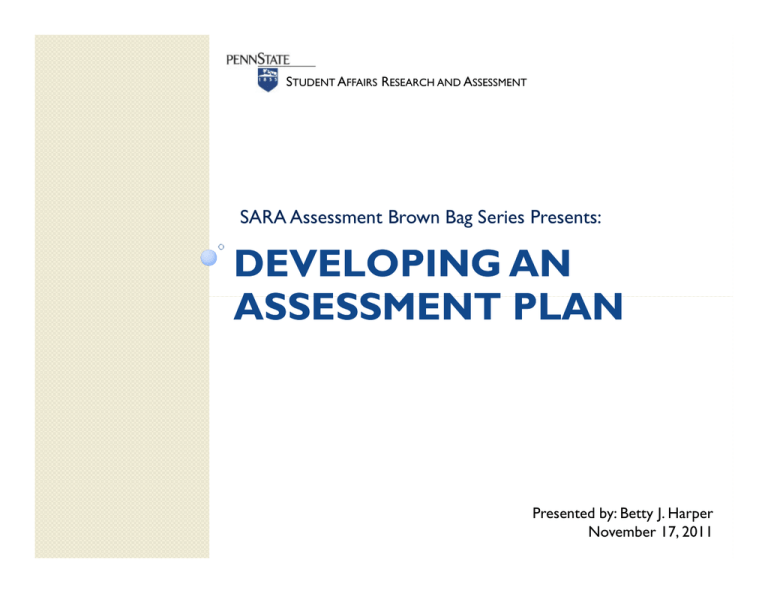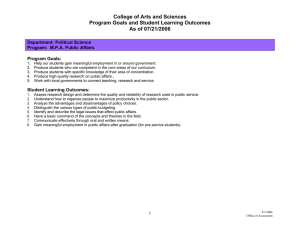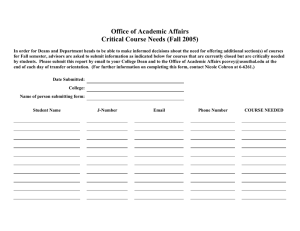DEVELOPING AN ASSESSMENT PLAN SARA Assessment Brown Bag Series Presents:
advertisement

STUDENT AFFAIRS RESEARCH AND ASSESSMENT SARA Assessment Brown Bag Series Presents: DEVELOPING AN ASSESSMENT PLAN Presented by: Betty J. Harper November 17, 2011 Why Create an Assessment Plan? y You wouldn’t build a house without a blueprint, would you? STUDENT AFFAIRS RESEARCH AND ASSESSMENT Start Small y Create a multi-year plan, but break it into manageable parts y Choose one or two outcomes to focus per year y on p y Measure these y Use the information to adjust your process y Document and disseminate STUDENT AFFAIRS RESEARCH AND ASSESSMENT Core Components of an Assessment Plan y Mission y Objectives y Outcomes y Evaluation methods y Implementation ◦ Who is responsible? ◦ Timeline y Results (when crafting your annual plan, briefly review findings and impacts from your previous efforts) y Dissemination and action plan STUDENT AFFAIRS RESEARCH AND ASSESSMENT Measurement Methods y Direct methods require students to display their knowledge and skills y Indirect methods ask students or someone else to reflect on the student learning rather than to demonstrate it y In Student Affairs we commonly use indirect methods, but ideally we should strive for a mix of direct and indirect STUDENT AFFAIRS RESEARCH AND ASSESSMENT Examples of Direct Evidence y Student work samples (a written speech, a journal, an event) y Portfolios y Observations of student behavior (leadership (leadership, communication, etc.) y Internal juried review of student projects y Evaluations of performance STUDENT AFFAIRS RESEARCH AND ASSESSMENT Examples of Indirect Evidence y Student, alumni, and employer surveys y Focus groups y Exit interviews y Percentage of students who go on to graduate school or job placement statistics y Percentage of students who participate STUDENT AFFAIRS RESEARCH AND ASSESSMENT Matrices Can Help You Lay Out a Plan Fall 2011 Outcome 1 O t Outcome 2 Spring 2012 Reflective writing evaluation Fall 2012 Spring 2013 One year followup interview Survey Outcome 3 Outcome 4 STUDENT AFFAIRS RESEARCH AND ASSESSMENT Focus group follow-ups to survey External review of student projects Peer evaluations Written evaluation from external collaborators Student Satisfaction (SP12) Outcome 1 z Outcome 2 z Outcome 3 z NSSE (FA12) Outcome 4 STUDENT AFFAIRS RESEARCH AND ASSESSMENT Pulse Survey (SP13) Student interviews (FA13) z z z Your Turn! y Use the handout to sketch out an assessment matrix. y The columns can be semesters, years, or specific assessment activities y The rows are learning outcomes (see example outcomes: http://edge.psu.edu/SAOutcomes.shtml) STUDENT AFFAIRS RESEARCH AND ASSESSMENT Making Use of the Data y Collect data from multiple sources y Collect actionable data y Report out! Findings should not be stored solely in your brain or your file cabinet y Organize reports around issues, not just data y Interpret data so that it informs your programming, budgeting, planning, decision-making, etc. STUDENT AFFAIRS RESEARCH AND ASSESSMENT Closing the Loop y Every assessment should have an accompanying report y Briefly document the methodology y Document where students are meeting the intended outcome and where they are not y Document decisions made as a result y Refine the assessment method and repeat the process STUDENT AFFAIRS RESEARCH AND ASSESSMENT Resources y Much of the material in this presentation is modified from Dr. Carrie L. Zelna’s, Basic Assessment Plan Development at http://www.ncsu.edu/assessment/old/presentatio ns/assess process/basic plan devt pdf ns/assess_process/basic_plan_devt.pdf. y SARA Assessment Plan Template STUDENT AFFAIRS RESEARCH AND ASSESSMENT Questions? Betty J. Harper, Director Student Affairs Research & Assessment BHarper@psu edu BHarper@psu.edu (814) 863-1809 STUDENT AFFAIRS RESEARCH AND ASSESSMENT

